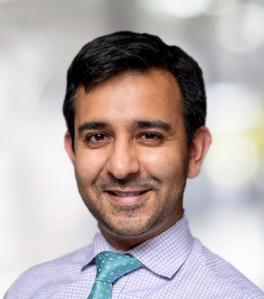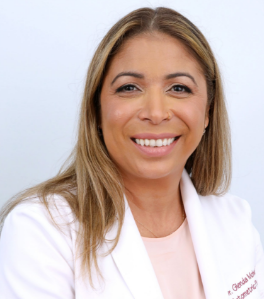Co-management in eye care suggests the answer is yes
Co-management in eye care represents a powerful shift towards collaborative practice, where optometrists and ophthalmologists work together to better address patients’ diverse needs. This approach prioritizes shared responsibility and open communication to optimize patient outcomes, particularly for conditions such as myopia and glaucoma.
I t started with a text message. “Hey, Rajen, this is a patient of mine.” The optometrist explained the situation—a patient on critical mental health medication that could potentially trigger narrow-angle glaucoma. Despite the risks, the medication was essential for the patient’s well-being. Stopping it wasn’t an option; nor was ignoring the possible danger to their vision.
Dr. Rajen Desai, a cataract and glaucoma surgeon with Precision Eye Partners in New Jersey, USA, got the text and sprang into action. He saw the patient the very next day, examined their eyes on and off the medication,
and determined that their ocular health was unaffected by the treatment.
The optometrist, psychiatrist and Dr. Desai collaborated seamlessly, ensuring the patient’s vision, mental health and overall quality of life were protected.
“It was a great way for a patient to keep not just their sight but their sanity, their life and their livelihood as well,” Dr. Desai reflected. “This wasn’t just about treating the eyes—it was about treating a human being.”
This scenario encapsulates the very essence of co-management: A patient-centric approach where optometrists and ophthalmologists join forces, blending their expertise to deliver holistic care. It’s a collaboration built on trust, communication and a shared commitment to doing what’s best for the patient.
For optometrists, co-management often means balancing the art of knowing your patient’s personal story with the science of knowing when to call on a specialist. It requires not only clinical expertise but also the ability to act as a bridge between patients and the wider medical team.
Dr. Desai’s case is far from unique, but it serves as a powerful reminder of what’s possible when providers set aside silos and focus on the bigger picture.
“Co-management isn’t about losing autonomy,” he emphasized. “It’s about leveraging each other’s strengths to provide better care.”
Co-management in a nutshell
At its core, co-management is about collaboration—a shared responsibility between optometrists and ophthalmologists to provide comprehensive care tailored to the patient’s unique needs. The goal is clear: Optimize outcomes by combining expertise, defining roles and maintaining open lines of communication.
But what does this look like in practice? Imagine a patient with keratoconus, a condition requiring both medical intervention and specialty vision correction.
“When I have a patient referred to me for scleral lenses, I make sure that we’re also addressing the main problem—keratoconus—which can be managed with cross-linking,” explained Dr. Glenda Aleman-Moheeputh, president and CEO of OK Love Myopia Control Experts in Florida, USA.
“So, I refer the patient to Dr. William Trattler (a refractive, corneal and cataract surgeon) for cross-linking. And vice versa: If he treats a patient for keratoconus and they need vision correction, he refers them to me for specialty contact lenses,” she said.
This kind of reciprocal relationship not only benefits the patient but also strengthens professional networks. Each provider understands their role—Dr. Trattler handles the stabilization of the disease, while Dr. Aleman-Moheeputh focuses on restoring functional vision.
For complex conditions like keratoconus, glaucoma or post surgical recovery, co-management isn’t just a convenience—it’s a necessity. By working together, optometrists and ophthalmologists can ensure continuity of care, tackle multifaceted challenges and, most importantly, prioritize the patient’s well-being.
“When done right, co-management is seamless,” noted Dr. Aleman Moheeputh. “It’s not just about solving a problem. It’s about treating the whole person.”
A new era of collaboration

The relationship between optometrists and ophthalmologists has come a long way from its polarized origins. Decades ago, the two professions often operated in isolation, with little interaction and even less collaboration.
“When I first moved to the US, it was polar opposites. Optometry was looked down upon,” reflected Dr. Aleman-Moheeputh, highlighting the stark divide that once defined the field.
But times are changing. Today, the increasing demand for eye care, advancements in technology and shifts in legislation have pushed the two professions toward a more integrated approach to patient care.
Key milestones have paved the way for this evolution. The introduction of protocols, such as the American Society of Cataract and Refractive Surgery co-management guidelines, established a framework for shared care models.*
More recently, legislative wins have expanded the scope of optometric practice in several states in the U.S., allowing optometrists to perform minor procedures and prescribe a broader range of medications. These changes not only improve access to care but also reinforce optometry’s role as a primary access point for patients.
Technology has further fueled this collaboration. Tools like optical coherence tomography (OCT) and advanced diagnostic imaging empower optometrists to detect and monitor conditions earlier and more accurately, opening new doors for cooperative care. Coupled with an aging population and rising rates of diabetes and myopia, the need for efficient, collaborative care models has never been greater.
In South Florida, the movement has gained notable momentum, thanks to trailblazers like Dr. Diana Schechtman. “She’s been a huge advocate for collaborative care,” said Dr. Aleman-Moheeputh. “She’s been proactively hosting events where optometry and ophthalmology are all in the same room.” These gatherings are more than symbolic gestures; they serve as platforms to build trust, exchange knowledge and strengthen the partnerships needed for effective co-management.
Building that trust, however, requires effort. “The best ophthalmologists are progressive and recognize optometry’s role as primary care providers,” Dr. Aleman-Moheeputh explained. But trust isn’t given—it’s earned. “For ophthalmologists to trust you, they need to know you are practicing science-based medicine,” she explained. “It’s about staying informed, communicating clearly and demonstrating expertise.”
This evolving relationship between optometrists and ophthalmologists isn’t just a professional shift—it’s a reflection of a broader cultural change within eye care. By prioritizing collaboration over competition and patient outcomes over individual egos, the two professions are unlocking a new potential for improved care.
Transforming myopia management
Myopia management stands out as an area ripe for collaboration between optometrists and ophthalmologists. As global cases of myopia surge, the stakes for early intervention and long term care have never been higher. Co-management offers not only the chance to preserve vision but also to enhance patients’ overall quality of life.
Optometrists’ accessibility and patient-facing roles position them as the first line of defense in managing myopia. Beyond just diagnosing refractive errors, optometrists serve as educators, helping patients and their families understand the long term risks of myopia progression.
“Optometrists have a unique opportunity to change the trajectory of conditions like myopia through early intervention and patient education. It’s a powerful responsibility,” noted Dr. Aleman-Moheeputh.
At the heart of successful co-management lies a stepwise, collaborative approach. Optometrists lead the charge by diagnosing myopia early, implementing treatments such as orthokeratology or atropine drops, and closely monitoring axial length. When a patient reaches critical milestones—like two years of stable axial growth or the emergence of retinal complications—ophthalmologists step in to provide advanced care.
“Once we have two years of stable axial length and stable refractive error, we revisit, and I would send the patient for a consultation for refractive surgery,” explained Dr. Aleman-Moheeputh. This continuity of care ensures patients receive the right intervention at precisely the right moments.
Effective co-management also hinges on seamless communication between providers, particularly for high-myopia patients who are at elevated risk for retinal pathology. Annual referrals to retina specialists are essential.
“We need to send them to the retina specialist at least once a year so they can make sure that the health of the retina is intact,” Dr. Aleman Moheeputh advised.
Real-world scenarios underscore the importance of this proactive strategy. “I had a patient who was very highly myopic. He came in for a follow-up, and I just had a feeling that day, intuition,” Dr. Aleman-Moheeputh shared. “He was not due for a dilation but that day something told me to dilate him. And I saw one retina hole. I immediately coordinated with a retina specialist,” she continued. The swift action helped the patient avoid potentially devastating vision loss.
As myopic patients near the end of their treatment journey, conversations around refractive surgery often take center stage. Here, close collaboration between optometrists and ophthalmologists becomes crucial.
“We plan one year before a patient ends their myopia management. We start the conversation… and I work very closely [with the ophthalmologist],” said Dr. Aleman-Moheeputh.
For many, early refractive surgery can be life-changing. “The reason why I advocate for refractive surgery is because, in the end, it’s what’s best for the patient…having refractive surgery early gives them quality of life,” she emphasized.
Co-managing glaucoma
Managing glaucoma is often likened to a marathon—a relentless, long term effort requiring meticulous monitoring and timely interventions. Optometrists typically serve at the front lines, detecting glaucoma through monitoring intraocular pressure (IOP) and conducting visual field tests. However, a frequent pitfall in co-management lies in delaying referrals for advanced intervention.
“A common mistake is not referring a patient soon enough,” Dr. Desai said. “Unfortunately, patients come to me too late, often at a severe stage of the disease. We often wait until the patient functionally loses their vision before we send them to a glaucoma specialist,” he explained. “It would have been nice to cut that little nodule out when it was the size of a peanut a year ago, five years ago or 10 years ago.
In his talks with optometrists, Dr. Desai often uses a striking analogy to drive home the urgency of early surgical intervention. “If someone had lung cancer and the tumor was growing, you wouldn’t keep trying different chemotherapies while the tumor spreads. You’d consider surgery early on,” he said. “We need to think about glaucoma the same way— intervene early to prevent suffering, costs and permanent vision loss.”
The evolving paradigm of interventional glaucoma has opened new opportunities for collaborative care. This approach allows optometrists and glaucoma specialists to work hand-in-hand, ensuring continuity of care while leveraging each other’s strengths.
“When I perform surgery, I see the patient postoperatively to ensure they’re stable,” Dr. Desai shared. “Once they’re good, I send them back to the optometrist for long-term care. They’ll monitor the patient, check the pressure and send the patient back to me if another intervention is needed. It works very well together.”
The key to successful glaucoma management lies in mutual trust, open communication and shared responsibility. For optometrists, understanding when to refer and maintaining ongoing dialogue with specialists can make all the difference in patient outcomes.
“The goal is to get patients off the cycle of drops and suffering and into a stable, manageable condition,” Dr. Desai concluded. “And that’s something optometrists and ophthalmologists can achieve together.”
A win-win for all
As the demand for eye care services continues to grow, the need for optometry and ophthalmology to work hand-in-hand has never been greater. Through collaboration, these professions can achieve faster diagnoses, improved patient outcomes and a more streamlined approach to care—setting a new gold standard for interdisciplinary partnership.
“We must advocate and promote collaborative care. Ultimately, it enables us to provide the best patient care,” Dr. Aleman-Moheeputh noted. This ethos is a call to action for optometrists to embrace co-management not as an obligation but as an opportunity to elevate the care they provide.
By working together, optometrists and ophthalmologists can address the growing prevalence of chronic conditions like myopia and glaucoma while also meeting the rising expectations of patients seeking comprehensive and personalized care.
“Patients receive the best care, and practitioners can rely on each other’s expertise. It’s a win-win situation,” Dr. Aleman-Moheeputh emphasized.
This partnership is more than just about efficiency—it’s about creating a shared vision for the future of eye care. With advancements in technology and an ever-expanding scope of practice, optometrists are uniquely positioned to play a central role in co-management models that benefit both patients and providers.
As the field of eye care evolves, so too must its leaders. The potential for co-management to redefine patient care is boundless, but it requires a unified effort to make it a reality. The future of eye care isn’t just about seeing clearly—it’s about working together to create a vision for all.
Editor’s Note: A version of this article was first published in COOKIE magazine Issue 18.
Reference
- American Society of Cataract and Refractive Surgery. Ophthalmic Postoperative Care. August 2016. Available at: https://ascrs.org/-/media/files/advocacy/ascrs-comanagement-guidelines.pdf. Accessed on December 19, 2024.





